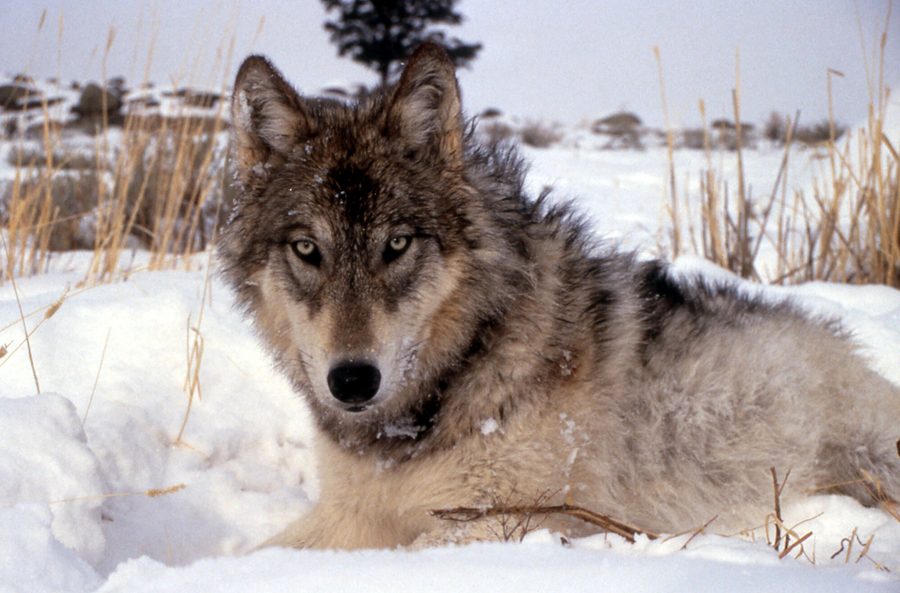In Wisconsin, an Overzealous Hunt Decimated the Local Wolf Population
A new report shows legal and illegal killings wiped out as much as a third of the state’s gray wolf population in 2021.
Christina Lieffring and Jonathon Sadowski

This article was published in collaboration with UpNorthNews and In These Times’ The Wisconsin Idea, an investigative reporting initiative focused on rural Wisconsin.
Wolf biologists and tribal nations voiced their objections going into Wisconsin’s court-ordered gray wolf hunt last February, and they were even more dismayed with how the hunt was planned and executed — early reports showed hunters killed almost double the allotted number of wolves.
But that startling figure only represents officially documented kills. Now that researchers have had time to assess the full extent of the hunt’s damage, they’ve found the outcome was far worse than initially reported: According to a report published by the Nelson Institute for Environmental Studies at the University of Wisconsin, legal and illegal killings wiped out as much as a third of the state’s gray wolf population.
After the Trump administration announced on Oct. 29, 2020 that it would remove gray wolves from the endangered species list, the Wisconsin Department of Natural Resources (DNR) started planning a wolf hunt for fall 2021. But on Feb. 11, in response to a lawsuit from the Wisconsin Institute for Law & Liberty (WILL) and a Kansas hunting organization, Jefferson County Judge Bennett Brantmeier ordered the DNR to organize a hunt by the end of the month.
The hunt began less than two weeks later, on Feb. 22, and the DNR shut it down in just 39 hours given the high initial kill totals. Hunters had 24 hours after closing to finish reporting their kills, and when the final numbers came in, the death toll stood at 216 wolves, almost double the DNR’s quota of 119.
There could have been even more wolf deaths; Wisconsin’s tribal nations declined to exercise their right to kill 81 wolves in their territories.
This month, the team of wolf researchers, headed by Adrian Treves with the Carnivore Coexistence Lab at UW-Madison, published a report that estimated that the wolf population had decreased by 27%-33% from an estimated population of 1,034 in April 2020 —leaving an estimated population range of 695-751 wolves as of April 15, 2021.
Treves estimates an additional 98 to 105 wolves have been killed since their delisting was announced, but he cautioned the number of unreported killings “could be much higher.”
“We only made bulletproof assumptions … that were more cautious, based on peer reviewed science,” Treves said in an interview.
He continued, “What it means is that our estimates of the population are, really, plausible maximum population status. It could be quite lower.”
Francisco Santiago-Ávila, a co-author on the study, said the additional killed wolves were likely the victims of illegal poaching, based on other research co-authored by Treves that found deslisting or downgrading wolves from their protections under the Endangered Species Act (ESA) leads to an increase in poaching.
“When you’re reducing protections for wolves in any way, be it through downgrading or delisting from the ESA … you’re sending a signal to would-be poachers on the landscape that either there are too many wolves on the landscape or that they are not valued as much anymore,” Santiago-Ávila said. “That essentially may incentivize the culling and concealing of wolves that are never reported.”
Santiago-Ávila said other potential reasons for losing track of the wolves — such as tracking collar malfunctions or migration — do not adequately explain the high number of wolves that go missing when their ESA status changes.
“The policy itself wouldn’t affect those two mechanisms,” Santiago-Ávila said. “The policy affects human behavior.”
Even before the report was published, Peter David, a biologist with the Great Lakes Indian Fish & Wildlife Commission (GLIFWC) — which regulates hunting, fishing, and gathering on tribal lands in Wisconsin, Michigan, and Minnesota — said he had already suspected the hunt was going to have an outsized impact on the wolf population.
According to David, the quota set by the DNR was higher than what scientific models recommended for the DNR to reach its stated goal of having no impact on the wolf population. The timing of the wolf hunt was particularly problematic: February is the point when the wolf population is the lowest and the beginning of the wolf breeding season; hunts are typically held in late fall or early winter.
“[The February hunt] is really unlike any other wolf harvest anywhere, that it was completely concentrated within that window,” David said. “All the factors make me think that the impact of this harvest was very substantial.”
Holding the hunt during the breeding season affects wolves’ ability to breed and return the population to pre-hunt levels. Charlie Rasmussen, also with GLIFWC, said GLIFWC biologists who examined some of the donated carcasses from the hunt found that one was an impregnated female with nine developing wolf fetuses.
“It was a difficult examination for GLIFWC biologists to do,” Rasmussen said.
Treves’ study recommended against holding a wolf hunt this November, which David and Rasmussen said is also the opinion of GLIFWC and the tribes they represent. There is precedent for this kind of policy shift: DNR announced this month that it will cancel the sharp-tailed grouse hunt for the third year in a row to protect that population. If this fall’s wolf hunt is cancelled, Treves’ study estimated it would take the wolf population one to two years to rebound to it’s April 2020 level.
More broadly, all of the researchers interviewed for this story agreed that there is no need to manage the wolf population at all.
“It’s important to recognize that wolves are very good at regulating their own numbers,” David said. “Because of their territorial behavior and other aspects, their numbers never get very high. And if you look at neighboring Minnesota or the upper peninsula of Michigan, both of those wolf populations have essentially plateaued without any hunting to drive their numbers down.”
Pro-hunt advocates argue the hunt is a way to mitigate the risk of wolves preying on livestock, other wild game, such as deer, or their risk to humans and pets. David said those arguments don’t stand up to scientific scrutiny.
While livestock predation is a legitimate concern, David said, a wolf hunt is not an effective way to address the issue. Instead, he said it’s more effective to continue using the system in which farmers contact federal officials who investigate the attacks and can take a number of steps to address the situation, such as killing or relocating the wolf.
“That kind of a response is very timely and it’s very targeted to the location and to the wolves that might be involved,” David said.
By contrast, David pointed out that nine of the ten of the wolves killed during the last hunt were more than eight miles from any confirmed sites where wolves had killed livestock.
“There’s very little reason to think that any appreciable number of those wolves were actually involved in depredations,” David said.
As for the arguments about human safety, David pointed out that it’s incredibly rare for a wolf to attack a human, and in those cases, addressing that individual wolf is more effective than a statewide hunt.
In response to hunters’ concerns about wolves killing deer, Treves argued that there are benefits to wolves preying on deer. For example, one study found that counties with wolves have lower rates of vehicles colliding with deer on the road.
Furthermore, Treves said, “In a state with over a million deer that are acknowledged to do hundreds of thousands of dollars of damage to crops and ornamentals and vehicles, we actually need more apex predators in this state to control the overwhelming deer population that’s acknowledged by scientists and public officials to be causing us a lot of problems.”
David also pointed to evidence that wolves help control the spread of chronic wasting disease, which is a substantial threat to the deer population and people or predators who consume infected deer. Overall, the researchers said, scientific studies have found that the benefits of having a healthy wolf population outweigh the small risks.
David doubts that ecological concerns are the true motivation for pro-hunt advocates, especially given the evidence that wolves benefit the natural environment. Instead, he believes the pro-hunt movement is motivated by novelty and revenge.
“It’s a novelty hunting experience, and it’s an opportunity to harvest something that people haven’t harvested before,” David said. “And for some people it’s truly a vengeance hunt … on occasion, [people] will lose dogs to wolves, when they’re training their dogs especially, and wolves have pups that they will defend. And this was a chance for, I think, the community to get revenge on the wolf population.”
Meanwhile, David argued, the cultural significance of the wolf to the Ojibwe “doesn’t get taken very seriously.” The tribes have told the DNR they do not support holding a wolf hunt this fall.
David and other biologists are the first to admit there’s a lot that researchers still don’t know about wolves and their ecological role. But David thinks that, given what humans do know, the DNR should seriously consider leaving wolf management to Mother Nature.
“I think oftentimes we are a bit arrogant and at what we think we understand,” David said. “Wolves are a natural part of this landscape for an incredibly long time, and ecologically, it’s reasonable to think that they have a valuable role here. And in all likelihood, we have barely scratched the understanding of that, so we need to be a little bit humble and give nature the benefit of the doubt.”
Christina Lieffring is the news and politics editor at Tone Madison and a freelance journalist in Madison, Wisconsin.
Jonathon Sadowski is managing editor of UpNorthNews, a progressive news site that covers all of Wisconsin. He is based in southeastern Wisconsin.





